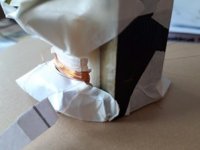This is the most important. Inrush current will be lower as the applied voltage is lower but the resistance is the same. Magnetic field will be the same as it is proportional to current and number of windings so if you use it at rated current this is identical.The VA rating is HALVED when the transformer is operated on half the rated line voltage.
Because: the current rating remains the same; it does NOT double.
Other thing to consider is that you will probably be working at 60Hz while the transformer is designed for 50Hz. This could give a bit more losses.
Working 240V iron at 120V, at half the VA, is twice the weight and almost twice the price of what you HAD to lift and pay.
For a minor function on a big costly amplifier, you may not sweat the extra pound; and sometimes "wrong" iron is found at lower price than "right" iron. I have 120/240/440 iron here that I bought at close-out for pennies on the dollar.
For a minor function on a big costly amplifier, you may not sweat the extra pound; and sometimes "wrong" iron is found at lower price than "right" iron. I have 120/240/440 iron here that I bought at close-out for pennies on the dollar.
Don't worry about frequency, Japanese sets were mostly 220 v 50 Hz / 110 v 60 Hz switchable for export in the Asian market. They had no issues with winding failures. Frequency is an issue with large distribution transformers, and the helix angle in motors is chosen for frequency.
You have a golf cart, compared to a truck.
Don't worry.
The lighter the load, the poorer the regulation.
Your choice, if it blows up, build another one....just kidding.
Run it at about 80% of (half) capacity, no problem.
You have a golf cart, compared to a truck.
Don't worry.
The lighter the load, the poorer the regulation.
Your choice, if it blows up, build another one....just kidding.
Run it at about 80% of (half) capacity, no problem.
Commercial transformers are not overdesigned, because of the cost of copper and the transformer physical size,
which would increase due to larger wire size. The wire is the smallest possible size to make the current rating.
this is the reason i design and build my own transformers...
running a power traffo meant to run 230 vac on 120 supply is not a big deal, heating is about 4x less, but the primary wire will likely be 3 sizes smaller and so will have higher dc resistance and so higher losses, the question is can you live with that? will this suit your needs?
The power losses would remain same at rated current (IsqR) since the DC resistances remain same.
Rated output is half with half supplied voltage at same full load amps. (V x I vs V/2 x I)
Available power at secondary is 'half rated power-same power loss'
Meaning the regulation will be bad.
Regards.
Rated output is half with half supplied voltage at same full load amps. (V x I vs V/2 x I)
Available power at secondary is 'half rated power-same power loss'
Meaning the regulation will be bad.
Regards.
Just found this thread while looking for an answer to the opposite question:
Will there be any problem when connecting a "110 V" primary winding to 230 V ac?
To be more precise: my 30 VA, 6+6 V transformer has two primary windings, to be used in series for 230 V and parallel for 110 V.
Before buying a new 12+12 V transformer I thought maybe I could try as written above - or is that a bad and dangerous idea?
Thanks!
Will there be any problem when connecting a "110 V" primary winding to 230 V ac?
To be more precise: my 30 VA, 6+6 V transformer has two primary windings, to be used in series for 230 V and parallel for 110 V.
Before buying a new 12+12 V transformer I thought maybe I could try as written above - or is that a bad and dangerous idea?
Thanks!
a 120v primary when connected to a 230v source saturated quickly and will burn....Just found this thread while looking for an answer to the opposite question:
Will there be any problem when connecting a "110 V" primary winding to 230 V ac?
To be more precise: my 30 VA, 6+6 V transformer has two primary windings, to be used in series for 230 V and parallel for 110 V.
Before buying a new 12+12 V transformer I thought maybe I could try as written above - or is that a bad and dangerous idea?
Thanks!
if you need a 12+12 vac secondary, you can still use that transformer, wire that for 230v primary, then series connect the 6 volt secondary, and then use a full wave voltage doubler psu...you do not need to buy a new transformer...
I thought center tap and one end for 2200V, and both ends for 110V were normal. Please post a picture of it, f possible.
But trying to double the voltage is going to start damaging things, even a burning of windings, dangerous.
Just buy a new transformer, SMPS have become cheaper than transformers, maybe LED driver can be used, if your circuit can withstand noise.
But trying to double the voltage is going to start damaging things, even a burning of windings, dangerous.
Just buy a new transformer, SMPS have become cheaper than transformers, maybe LED driver can be used, if your circuit can withstand noise.
thank you again, tony and @NareshBrd !you do not need to buy a new transformer...
I wanted to try something new and added additional secondary windings with a very thin insulated wire (0,11 mm).
the winding provide about 11,9 V and a short circuit current of 0,46 A, which is plenty for the negative op-amp rail I use it for.
I first thought adding about 100 windings of thin wire will not work or at least take forever, then I found a way to do it quite efficiently.
I added some guiding paper and used a paper strip loop to thread the wire through the narrow gap between existing winding and core.
by winding double wire and then connecting one end to the other center the necessary thread through actions were halved.
after completing the windings I secured them with tape and epoxy.




It will have lighter gauge on the primary but it will be able to supply half the power as before so primary current will stay same as before.The reason I asked about current de-rating is because I'm guessing the windings for a 230 volt primary will have lighter gauge winding wire than a comparable 120 volt winding that is rated for same current. Hence it might get hotter when trying to supply the same current.
That said, the primary winding should also have a higher impedance so maybe it won't matter.
These were my thoughts and why I asked.
In a nutshell: all currents: primary and secondary stay the same (so wire gauge is fine), all voltages are halved, power is halved
You are simply wasting a good chunk of copper and iron.
Personally I'd get the proper transformer.
And possibly spoiled it by changing / closing the air gap, which is a design feature in transformers.
Be careful.
Be careful.
if this is meant for me: the few very thin windings did not fill up the gap, it did barely change at all. Do you still think there could be a problem?by changing / closing the air gap
When dealing with anything like transformers and motors HEAT is the biggest enemy. Running a 240 volt transformer on 120 halving the VA rating is a good idea. Surge is also a consideration.. Biggest thing is how long is the surge going to last. Most transformers will a 100% overload for a short amount of time.
If the wire can dissipate fast enough there will be no problem. I generally see control transformers pull 500% for a short time before the magic smoke comes out
If the wire can dissipate fast enough there will be no problem. I generally see control transformers pull 500% for a short time before the magic smoke comes out
- Home
- Amplifiers
- Power Supplies
- Using 230v transformer on 120v?